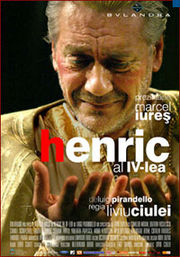
Bulandra Theatre
Encyclopedia

Bucharest
Bucharest is the capital municipality, cultural, industrial, and financial centre of Romania. It is the largest city in Romania, located in the southeast of the country, at , and lies on the banks of the Dâmbovița River....
, Romania
Romania
Romania is a country located at the crossroads of Central and Southeastern Europe, on the Lower Danube, within and outside the Carpathian arch, bordering on the Black Sea...
was founded in 1947 as Teatrul Municipal; its first director was Lucia Sturdza Bulandra, one of the leading Romanian stage actresses of her generation. Liviu Ciulei
Liviu Ciulei
Liviu Ciulei was a Romanian theater and film director, film writer, actor, architect, educator, costume and set designer. During a career spanning over 50 years, he was described by Newsweek as "one of the boldest and most challenging figures on the international scene".-Biography:Born in...
was director between 1963 and 1972;one of the most important directors of the late times was Stefan Iordanescu (1999 - 2002), who restructured the theatre management; since 2002, the theatre has been directed by Alexandru Darie.
Since 1991, the Bulandra Theatre has been a member of the Union of European Theatres, which was founded in March 1990. The theatre currently has two stages, located about 1.5 kilometers apart from one another, Sala Izvor (renovated 2002) near the Dâmboviţa River
Dâmbovita River
Dâmbovița is a river in Romania. It has its sources in the Făgăraş Mountains, on the Curmătura Oticu. The upper reach of the rivers, upstream of the confluence with the Boarcăşu River is also known as Izvorul Oticului River or Oticu River....
, not far from the southwest corner of Cişmigiu Garden, and Sala Toma Caragiu
Toma Caragiu
Toma Caragiu was a prolific Romanian theatre, television and film actor.He was born in an Aromanian family, in the Greek village of Aetomilitsa, in the region of Epirus on August the 21st 1925. Toma Caragiu was one of the best Romanian actors, with a rich activity in both film and theatre...
(renovated 2003), about half a kilometer southeast of Piaţa Romană
Piata Romana
Piaţa Romană is a major traffic intersection in Sector 1, central Bucharest.Two major boulevards intersect in Piaţa Romană: Lascăr Catargiu Boulevard and Magheru Boulevard . The two roads also coincide geographically with the Bucharest Metro Line M2...
, just east of the Grădina Icoanei
Gradina Icoanei
Grădina Icoanei is a small park in central Bucharest, situated not far away from Piaţa Romană and Bulevardul Magheru.The Bulandra Theatre , Ioanid Park , the Icoanei Church and the Anglican Church are located in the park's immediate vicinity....
park.
Originally Teatrul Municipal, the theatre later acquired the name Teatrul Lucia Sturdza Bulandra, now shortened to Teatrul Bulandra. The present Sala Izvor was and remains the headquarters, housing offices as well as the actual theatre space. Before Communist times
Communist Romania
Communist Romania was the period in Romanian history when that country was a Soviet-aligned communist state in the Eastern Bloc, with the dominant role of Romanian Communist Party enshrined in its successive constitutions...
, the second hall, located by Grădina Icoanei
Gradina Icoanei
Grădina Icoanei is a small park in central Bucharest, situated not far away from Piaţa Romană and Bulevardul Magheru.The Bulandra Theatre , Ioanid Park , the Icoanei Church and the Anglican Church are located in the park's immediate vicinity....
and designed by architect Ion Mincu
Ion Mincu
Ion Mincu was an architect, engineer, professor and politician in Romania.He promoted a Romanian style in architecture, by integrating in his works the specific style of traditional Romanian architecture...
, was the auditorium of a private school, Şcoala Centrală de Fete [Central Girls' School], located on Icoanei Street. After nationalization, the hall was first renamed after Filimon Sârbu
Filimon Sârbu
Filimon Sârbu was a Romanian communist activist and anti-fascist militant executed by the pro-Nazi authorities during World War II. After the war, he was acclaimed as a hero by the communist government....
, then later took its present name, in memory of actor Toma Caragiu
Toma Caragiu
Toma Caragiu was a prolific Romanian theatre, television and film actor.He was born in an Aromanian family, in the Greek village of Aetomilitsa, in the region of Epirus on August the 21st 1925. Toma Caragiu was one of the best Romanian actors, with a rich activity in both film and theatre...
.

